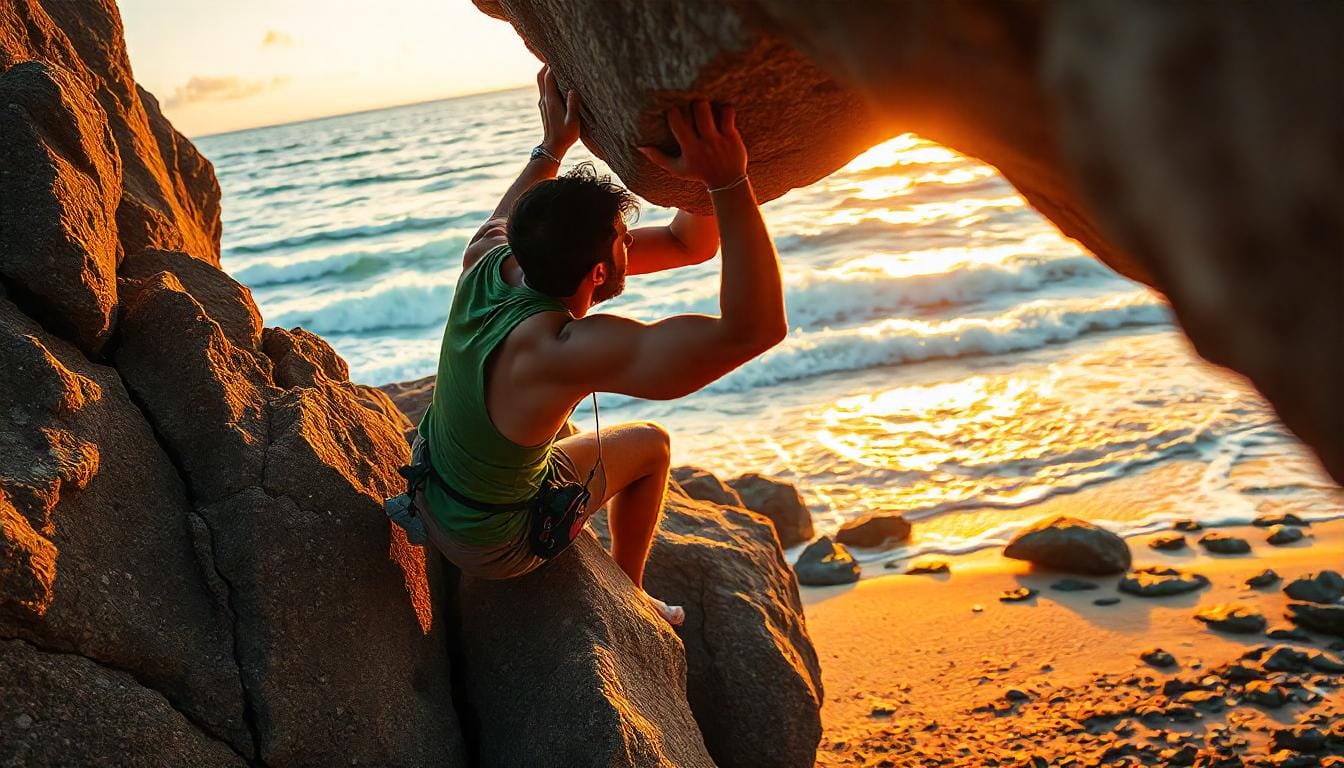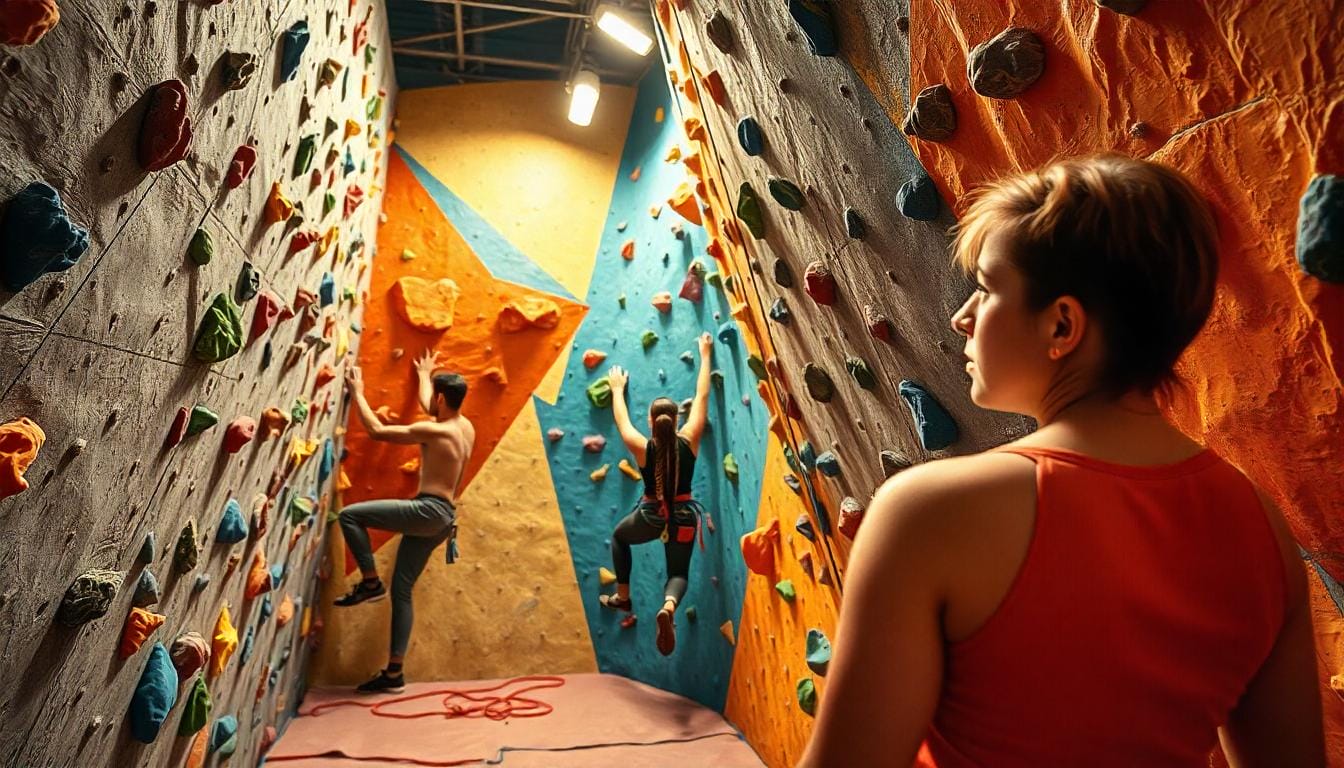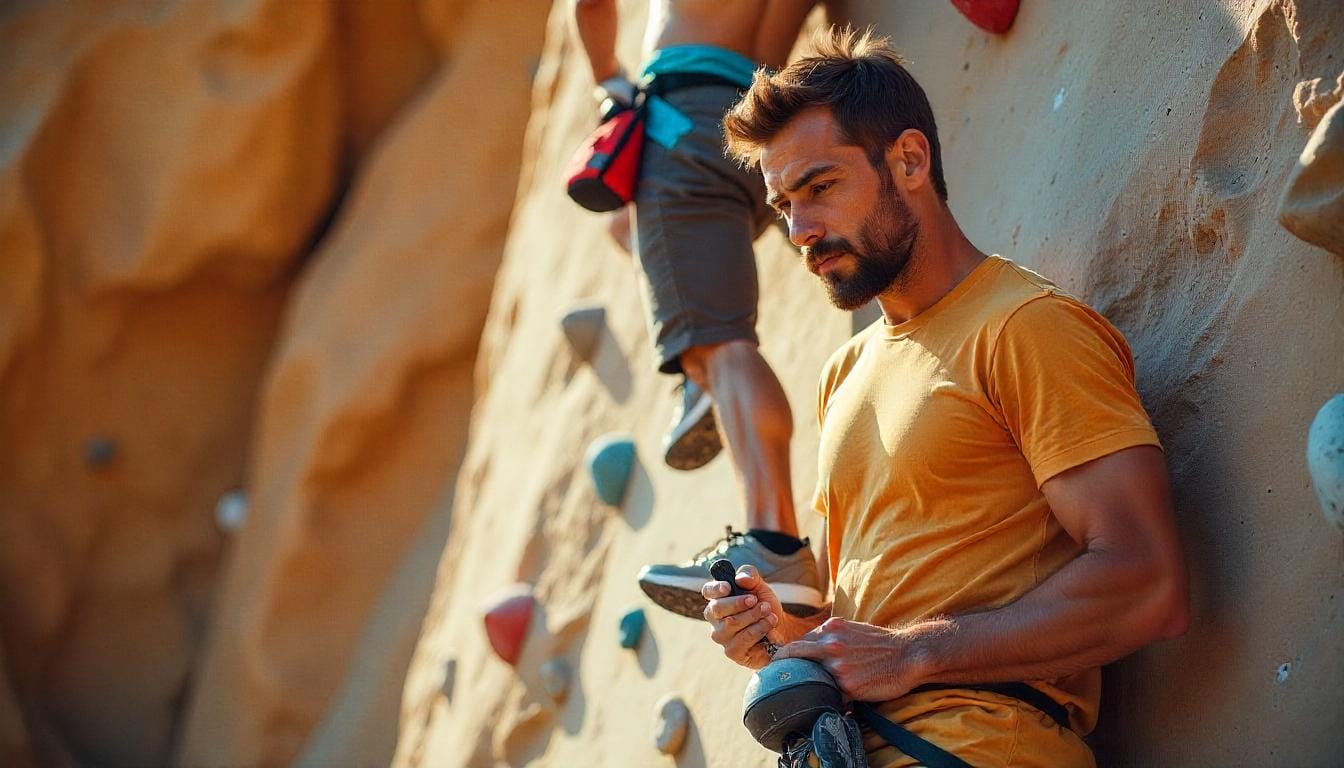Bouldering is an enjoyable way to climb. It involves tackling small rock walls without ropes and usually reaches heights of 10 to 13 feet. Climbers use crash pads to ensure a safe landing. This sport focuses on both strength and problem-solving skills, so staying relaxed is key. It’s perfect for anyone looking for a physical challenge. For those eager to learn more about starting bouldering, there are plenty of helpful tips and tricks ahead. Keep reading to discover how to get started and enjoy this exciting activity!
Key Takeaway
- Bouldering can be done indoors or outdoors.
- Safety is very important when climbing.
- Learning good techniques helps you climb better.
What is Bouldering?
Credits : Depot Climbing
Climbing rocks without ropes? Sounds crazy, but that’s exactly what bouldering is all about! This rad sport lets people scale short cliffs and rock walls using just their hands and feet. No ropes or harnesses needed for these daring dudes and dudettes.
The climbs are usually between 10 and 13 feet high, so boulderers aren’t going super high, but they make up for it with hard problems and dynamic moves. Scrambling up the rock face takes brains as much as brawn. Climbers have to strategize to find the best path using the hand and footholds available. It’s like a vertical puzzle!
Chalk helps keep palms dry for better grip, and tight climbing shoes let feet stick to the tiniest ledges. Boulderers gotta be creative in how they twist and stretch their bodies to reach the top. There’s no set route, so the climber has to figure out their own way.
Indoor bouldering walls have different climbing problems all over for a constant challenge. Outdoors, mother nature provides the holds, and no two rock faces are the same. There’s always a new problem to solve when bouldering, whether at the gym or on real mountain rock. Pretty rad! (1)
Getting Started with Bouldering
Starting something new can seem scary, but bouldering is worth a try! Here’s some tips to help total newbies get their climb on.
First things first – find a good place to boulder. Hit up a local climbing gym to see if they have beginner classes and bouldering walls. Or scout out some short outdoor rock faces to scramble up. Look for spots that welcome new climbers so you can learn the ropes in a friendly environment.
When checking out gyms, see if they offer rental gear. That way you can test drive shoes and chalk before buying your own. Many gyms even have starter packages so you can get outfitted on the cheap.
If heading outdoors, be safe and smart. Snag a crash pad to protect against falls and bring a buddy to spot you. Having a friend there makes it more fun too!
Wear comfy stretchy clothes that don’t restrict movement. You gotta let those limbs loose to find the best holds and make those sweet dynamic moves.
Once you find a spot, start easy and don’t be shy. Join newbie sessions at the gym or just practice basic techniques on your own. Focus on using your feet right and staying relaxed as you climb. No need to rush it, just enjoy yourself and the awesome feeling of defying gravity! (2)
Key Techniques for Bouldering
Bouldering takes more than strong arms – you gotta be smart with your moves! Here’s some key tricks of the trade:
- Footwork is everything! Place those puppies carefully on the best holds to reach higher hand grips. Let your feet do the hard work.
- Get your body in the right position. Shift your weight just so, and use neat tricks like heel hooks to get closer to the wall. Proper form is power!
- Chill out! Tense muscles make for tough climbing. Take some deep breaths and stay calm and loose. A relaxed climber is a better climber.
- Build those hand muscles! Strong fingers are great for latching onto tiny holds. Squeeze a stress ball or hang from a bar to get that grip strength up.
- Watch and learn. Study how experienced climbers do it. Their techniques and strategies can help newbies improve fast.
- Land safe! Practice falling and rolling so you stick the landing. Knowing how to fall is key for adventurous boulderers.
So get out there, use your noodle, and have an awesome time climbing! Being smart will make you a better boulderer.
Tips for Beginners
New to bouldering? No worries, you’ll be crushing it in no time with these handy tips:
- Peep the pros – Watch how the seasoned climbers do their thing and learn their secrets. Imitation is the sincerest form of flattery!
- Falling isn’t failing – Getting comfy taking tumbles is all part of bouldering. Practice those safe falls so you can climb without fear.
- Start easy – Each climbing problem has a grade so you can find ones that match your skill level. Build up from the easier grades as you gain experience.
- Make friends – Climbers like to help each other out with tips, cheers and high fives. The social vibe makes bouldering even more rewarding.
- Join the crew – Many gyms have climbing clubs and groups. Great way to meet fellow boulderers and get connected.
- Set goals – Pick out some fun looking problems and make it your mission to send them! Having goals keeps you motivated.
- Enjoy the ride – Laugh, whoop and have a blast on the wall. Climbing should be a good time, even as a beginner.
Stick with it and you’ll be crushing those bouldering problems in no time! Sending the vibe your way! (3)
Safety Practices in Bouldering
When it comes to bouldering, safety first! This rad sport is super fun, but you gotta be smart and take care of yourself. Here’s some tips:
- Crash pads are your best buds for outdoor climbing. Having padding to land on makes falls less ouchie.
- Climb with a pal who can spot you. Your climbing buddy can help guide you if you slip so you don’t get hurt.
- Learn to fall like a pro! Practice landing on your feet and rolling with the fall. Falling right = less injuries.
- Scope out the area before climbing. Make sure the landing zone is clear of sticks, rocks and other ouch-makers.
- Indoor gyms usually have padding and staff to keep you safe. But stay alert! Use good form and techniques.
- Listen to your body. Got some pains? Take a break! Pushing through will just make it worse later.
- Check your ego at the door. Attempting climbs too advanced for your skill level can lead to accidents.
Staying safe means you get to keep on bouldering and crushing it! Use your head and take care of your bod. Happy (and safe) climbing!
Types of Climbing Problems
Bouldering problems come in all shapes and sizes to keep things interesting! Here’s some of the different challenges you might run into:
Vertical climbs – Straight up the wall! Really works those arm and back muscles.
Traverses – Climbing sideways across the wall. Gotta use your noggin to plot the best route using the holds.
Each problem has a grade so you can find ones suited for your skill level. Start easy and work your way up as you improve!
It’s normal to hit plateaus where you feel stuck. Don’t sweat it! Just focus on building strength or learning new techniques to breakthrough.
Asking other climbers for beta (advice) can give you fresh ideas to try. Having a climbing buddy helps motivate too.
Even when you don’t top out, you can still learn something. Every attempt makes you a better climber, so keep on crushing!
There’s always a new challenge on the wall. That’s what makes bouldering so rad – it never gets boring!
Engaging and Fun Experience
Forget treadmills – bouldering is the fun way to break a sweat! This adventure sport gets your whole bod moving and grooving up the wall. Climbers build muscle, flexibility and get a killer grip while playing on the rocks. It’s like a hardcore jungle gym for grown-ups!
The best part? It doesn’t feel like exercise because you’re so focused on solving the climbing puzzles. All that matters is having a blast with your climbing crew and pushing yourself a little further each time.
The thrill of the climb does wonders to relieve stress and clear your head. It’s hard to worry about everyday stuff when you’re using all your wits to stick that tricky heel hook!
And the community spirit can’t be beat. Climbers cheer each other on and share beta to help you send that project you’re working. Fist bumps all around!
Reaching a hold you once thought impossible is the ultimate rush. The sense of accomplishment will have you hungry for the next challenge on the wall.
So leave your worries at the door, and come get your climb on! Bouldering is the cure for the common workout and open to everyone seeking adventure.
Climbing Gear for Bouldering
Wanna be a bouldering dude or dudette? You just need a few key things:
- Climbing shoes – These special kicks grip like glue to help you stick to those tiny holds. Don’t scrimp on these babies!
- Crash pads – Cushion your falls and keep you smiling. A good pad is a must for outdoor adventuring.
- Chalk bag – Keep those paws dry for better grip with this handy pouch of chalk.
Luckily, most gyms rent shoes and provide chalk so newbies can gear up easy. Consider trying before buying as you get into the sport more.
When heading outside, always pack your crash pad. It’ll save your tush if you take a tumble off the rocks. Safety first!
And don’t forget comfy clothes you can move in. You gotta let those limbs loose to bust out the sweet moves.
With the right gear, you’ll be crushing it in no time. Now lace up those shoes and get climbing, you bouldering machine!
FAQ
Tips for Beginners: What Should I Know Before Starting Bouldering Indoors?
Indoor bouldering is a fun way to start climbing. You’ll need climbing shoes that fit snugly, a chalk bag with liquid chalk or regular chalk for grip, and comfortable clothes. Most bouldering gyms provide crash pads for safety. Start with bigger starting holds near the ground and learn basic climbing techniques before trying harder problems.
What Equipment Do I Need for Climbing and Bouldering?
For bouldering basics, you need less gear than sport climbing. Essential items include well-fitted bouldering shoes (slightly smaller than street shoes), chalk bags, and comfortable clothes that allow full body movement. Many gyms rent this equipment if you’re just starting out.
How Do Bouldering Grades and Grading Systems Work?
Route setters use different grading systems to mark difficulty levels of boulder problems. In the US, problems are graded using the “V” scale (V0-V16). Each grade indicates the climbing techniques and strength training needed. Remember that grades are subjective and vary between bouldering areas and climbing walls.
What Makes Bouldering Different from Other Forms of Climbing?
Bouldering requires shorter but more intense climbing on smaller holds without ropes. You climb to the top of the wall (usually under 15 feet) focusing on dynamic movements and maintaining points of contact. Unlike sport climbing, bouldering emphasizes power over endurance.
What Are Key Tips for Bouldering Outdoors?
Outdoor bouldering needs extra preparation beyond indoor bouldering. Bring multiple chalk bags, crash pads, and sturdy climbing shoes. Check weather conditions and bring autorenew packs of chalk. Always climb with partners and respect the natural bouldering areas.
How Can I Improve My Climbing Techniques as a Beginner?
Learn proper footwork on the climbing wall before attempting complex moves. Focus on your form and body positioning. Start with easier bouldering problems and gradually increase difficulty.
What Should I Expect in a Bouldering Gym?
Most bouldering gyms have varied climbing grades suitable for beginner bouldering. Staff can help explain the grading systems and basic safety rules.
How Often Should I Practice Bouldering?
For best climbing results, practice 2-3 times weekly. This allows your body to adapt to the unique strength requirements that bouldering requires.
What Safety Tips Should I Remember?
Always check your points of contact and positioning. Have a spotter when trying challenging problems, especially when working on dynamic movements.
How Do I Choose the Right Problems to Work On?
Start with basic bouldering problems that match your skill level. Watch experienced climbers tackle similar difficulty levels to learn proper techniques.
Conclusion
Bouldering is a fun sport that anyone can try. With the right techniques and safety measures, anyone can enjoy climbing both inside and outside. It provides great physical exercise and mental challenges. Plus, bouldering helps build a strong community of climbers who support each other. Whether a beginner or experienced, anyone can enjoy this engaging activity that combines fitness, focus, and friendship.
References
- https://www.menshealth.com/uk/adventure/a61436815/what-is-bouldering/
- https://www.menshealth.com/fitness/a37246058/bouldering-beginners-guide/
- https://www.sanantoniomag.com/6-tips-for-bouldering-in-san-antonio/






